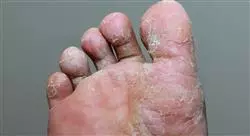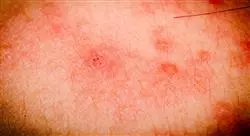University certificate
The world's largest faculty of medicine”
Introduction to the Program
This program will provide you with a sense of confidence in medical practice, which will help you grow personally and professionally”
Clinical Dermatology has been gaining prominence as the pathophysiological mechanisms of the pathological processes affecting the skin and its annexes have become better understood. As a result, the means and ways of treating the diseases that manifest themselves in the skin have become more widely known. In fact, in recent times it has become a recurrent discipline in different sectors of care, being a common reason for consultation, both at primary and specialized care level.
This scenario brings with it the challenge of maintaining a level of care that meets the new needs of the patient. For this reason, it is essential that the professionals who provide care to patients with dermatological pathology are properly qualified and have up-to-date knowledge in order to implement quality medicine.
At the diagnostic level, the advances that are being made in the knowledge of the etiology of each of the diseases, emerging pathologies, new imaging and laboratory techniques and diagnostic algorithms that are in continuous renewal, leads us to the need to keep our knowledge of pediatric dermatology and other related specialties (pediatrics, genetics, radiology, etc.) that experience constant innovation. At the therapeutic level, the appearance of new drugs and techniques for already known pathologies and the need for new strategies for the integral approach to the patient make it more than necessary to know all the arsenal of resources that we could, if necessary, use to attend to our patients with the maximum guarantee. The program is designed to provide an online specialization equivalent to 3,000 hours, and all theoretical and practical knowledge is presented through high-quality multimedia content, analysis of clinical cases prepared by experts, master classes and video techniques that allow the exchange of knowledge and experience, maintain and update the educational level of its members, create protocols for action and disseminate the most important developments in the specialty. With online education, students can organize their own learning process, adapting it to their schedules, in addition to being able to access the contents from any computer or mobile device.
This comprehensive program is designed for medical specialists interested in learning about the latest advances in the field of clinical dermatology and pediatric dermatology. In addition, this specialization program may be of interest to physicians from other specialties who wish to update their knowledge in a convenient way, without having to attend frequent scientific meetings or take multiple short specialization programs for each area of interest.
Join the vanguard in general and pediatric dermatology with a high-intensity and high-quality specialization, without having to give up your obligations”
This Advanced master’s degree in Clinical Dermatology contains the most complete and up-to-date scientific program on the market. The most important features include:
- This Advanced Master’s Degree in Clinical Dermatology contains the most complete and up-to-date scientific program on the market. The most important features include:
- More than 100 clinical cases presented by experts in the different specialities
- The graphic, schematic, and practical contents with which they are created, provide scientific and practical information on the disciplines that are essential for professional practice
- Diagnostic and therapeutic innovations on the most frequent skin diseases
- Presentation of practical workshops on procedures, diagnosis, and treatment techniques
- Contains real images in high resolution and practical exercises where the self-evaluation process can be carried out to improve learning
- Algorithm-based interactive learning system for decision making on clinical situations posed with a special emphasis on evidence-based medicine and research methodologies in dermatology
- All of this will be complemented by theoretical lessons, questions to the expert, debate forums on controversial topics, and individual reflection assignments
- Content that is accessible from any fixed or portable device with an Internet connection
This Advanced master’s degree is the best investment you can make when selecting a refresher program, for two reasons: in addition to updating your knowledge in Clinical Dermatology, you will obtain a qualification from TECH Global University"
Forming part of the teaching staff is a group of professionals from the field of dermatology, who bring to this course their work experience, as well as a group of renowned specialists, recognized by esteemed scientific communities.
The multimedia content developed with the latest educational technology will provide the professional with situated and contextual learning, i.e., a simulated environment that will provide an immersive program to learn in real situations.
This program is designed around Problem-Based Learning, whereby the physician must try to solve the different professional practice situations that arise during the course. For this purpose, the physician will be assisted by an innovative interactive video system created by renowned and experienced experts in the field of Clinical Dermatology with extensive teaching experience.
Increase your decision-making confidence by updating your knowledge through this Advanced master’s degree of a program created to train the best"
Take the opportunity to learn about the latest advances in Clinical Dermatology and improve the care of your patients with a high-level of competent assistance"
Why study at TECH?
TECH is the world’s largest online university. With an impressive catalog of more than 14,000 university programs available in 11 languages, it is positioned as a leader in employability, with a 99% job placement rate. In addition, it relies on an enormous faculty of more than 6,000 professors of the highest international renown.

Study at the world's largest online university and guarantee your professional success. The future starts at TECH”
The world’s best online university according to FORBES
The prestigious Forbes magazine, specialized in business and finance, has highlighted TECH as “the world's best online university” This is what they have recently stated in an article in their digital edition in which they echo the success story of this institution, “thanks to the academic offer it provides, the selection of its teaching staff, and an innovative learning method aimed at educating the professionals of the future”
A revolutionary study method, a cutting-edge faculty and a practical focus: the key to TECH's success.
The most complete study plans on the university scene
TECH offers the most complete study plans on the university scene, with syllabuses that cover fundamental concepts and, at the same time, the main scientific advances in their specific scientific areas. In addition, these programs are continuously being updated to guarantee students the academic vanguard and the most in-demand professional skills. In this way, the university's qualifications provide its graduates with a significant advantage to propel their careers to success.
TECH offers the most comprehensive and intensive study plans on the current university scene.
A world-class teaching staff
TECH's teaching staff is made up of more than 6,000 professors with the highest international recognition. Professors, researchers and top executives of multinational companies, including Isaiah Covington, performance coach of the Boston Celtics; Magda Romanska, principal investigator at Harvard MetaLAB; Ignacio Wistumba, chairman of the department of translational molecular pathology at MD Anderson Cancer Center; and D.W. Pine, creative director of TIME magazine, among others.
Internationally renowned experts, specialized in different branches of Health, Technology, Communication and Business, form part of the TECH faculty.
A unique learning method
TECH is the first university to use Relearning in all its programs. It is the best online learning methodology, accredited with international teaching quality certifications, provided by prestigious educational agencies. In addition, this disruptive educational model is complemented with the “Case Method”, thereby setting up a unique online teaching strategy. Innovative teaching resources are also implemented, including detailed videos, infographics and interactive summaries.
TECH combines Relearning and the Case Method in all its university programs to guarantee excellent theoretical and practical learning, studying whenever and wherever you want.
The world's largest online university
TECH is the world’s largest online university. We are the largest educational institution, with the best and widest online educational catalog, one hundred percent online and covering the vast majority of areas of knowledge. We offer a large selection of our own degrees and accredited online undergraduate and postgraduate degrees. In total, more than 14,000 university degrees, in eleven different languages, make us the largest educational largest in the world.
TECH has the world's most extensive catalog of academic and official programs, available in more than 11 languages.
Google Premier Partner
The American technology giant has awarded TECH the Google Google Premier Partner badge. This award, which is only available to 3% of the world's companies, highlights the efficient, flexible and tailored experience that this university provides to students. The recognition as a Google Premier Partner not only accredits the maximum rigor, performance and investment in TECH's digital infrastructures, but also places this university as one of the world's leading technology companies.
Google has positioned TECH in the top 3% of the world's most important technology companies by awarding it its Google Premier Partner badge.
The official online university of the NBA
TECH is the official online university of the NBA. Thanks to our agreement with the biggest league in basketball, we offer our students exclusive university programs, as well as a wide variety of educational resources focused on the business of the league and other areas of the sports industry. Each program is made up of a uniquely designed syllabus and features exceptional guest hosts: professionals with a distinguished sports background who will offer their expertise on the most relevant topics.
TECH has been selected by the NBA, the world's top basketball league, as its official online university.
The top-rated university by its students
Students have positioned TECH as the world's top-rated university on the main review websites, with a highest rating of 4.9 out of 5, obtained from more than 1,000 reviews. These results consolidate TECH as the benchmark university institution at an international level, reflecting the excellence and positive impact of its educational model.” reflecting the excellence and positive impact of its educational model.”
TECH is the world’s top-rated university by its students.
Leaders in employability
TECH has managed to become the leading university in employability. 99% of its students obtain jobs in the academic field they have studied, within one year of completing any of the university's programs. A similar number achieve immediate career enhancement. All this thanks to a study methodology that bases its effectiveness on the acquisition of practical skills, which are absolutely necessary for professional development.
99% of TECH graduates find a job within a year of completing their studies.
Advanced Master's Degree in Clinical Dermatology
Given the significant increase in the number of patients who demand increasingly effective and specialized techniques and procedures, the advances in the area of dermatology are evident. However, the increase of interventions that guarantee an adequate diagnosis and treatment for the different pathophysiologies that affect the skin, makes it essential to update dermatologists. In this sense, TECH Global University developed the Advanced Master's Degree in Clinical Dermatology, a program through which you will have access to the latest scientific and technological developments in this discipline to respond adequately in the assistance of the affected area, both in adult and pediatric patients.
Specialize in the largest Faculty of Medicine
If you want to stand out as an expert in this area offering a safe and effective service, with a solid base of knowledge and technical skills, this program is for you. You will be able to specialize in the latest advances in the dermatological area and its clinical application through a theoretical-analytical study in which you will identify the different types of dermatological diseases; you will recognize the signs, symptoms and level of severity presented by the different cutaneous manifestations and you will establish the appropriate procedures. At TECH Global University you will take the definitive step to reach a new level of knowledge and become a highly qualified dermatologist, as well as a key player in today's job market.









